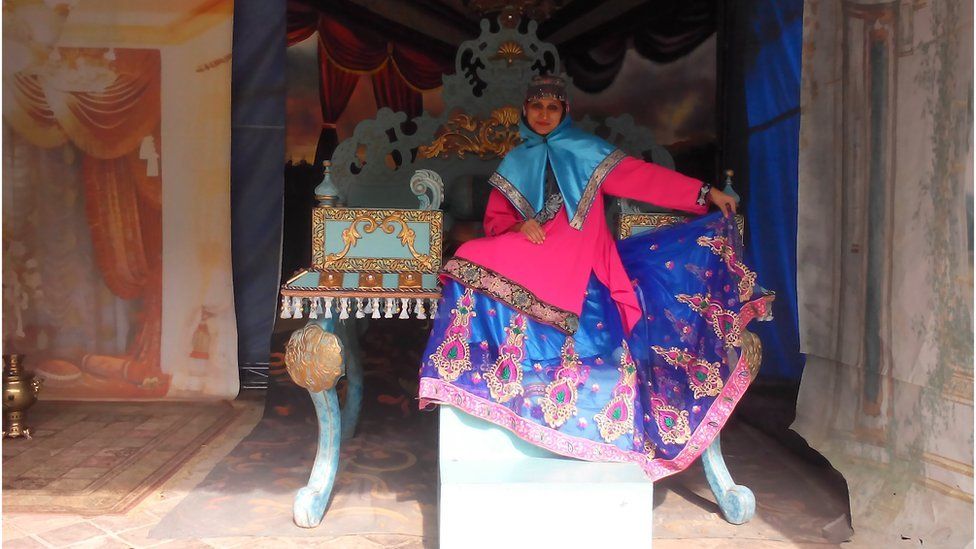India-Iran relations: Why Bollywood is our common language
- Published

With Indian Prime Minister Narendra Modi visiting Iran, there's been lots of talk in Delhi about the relationship between our two countries. But for me, a holiday I had in Iran last year told me more about our middle eastern neighbour than any political pundit could.
1. We are all Shah Rukh Khan fans
When I travelled to Iran last year, I received a warm welcome from many strangers - in part because the subject of Bollywood is great icebreaker.
On my first day in Tehran, a guard outside the Sadabad Palace museum asked me shyly: "Are you Hindustani (Indian), do you know Shah Rukh Khan?"
For the uninitiated, Shah Rukh Khan is one of the biggest superstars of Indian cinema with a fan following around the world.
As my friend and I took a selfie with the Iranian Bollywood fan, something inside told me that I was in for a treat. And I wasn't wrong.
2. A secret love of lipstick
During my travels, as I was getting myself photographed in local attire, an old lady came towards me.
We tried to communicate, but couldn't understand each other's language.
Then she mimicked an Indian lady applying lipstick and a Bindi (an adornment worn on the forehead by some Indian women).
Once I realised what she wanted, I handed her my lipstick. She deftly applied it on her lips, looked in the mirror and blushed like a new bride.
Then she furiously removed the lipstick, as if someone was watching over her.
Before I knew it, she had planted a kiss on my cheeks, hugged me and left. I can still feel the warmth of that hug.
I don't know what her reasons were. All I know that this was a moment of female solidarity that needed no words.
3. Fashion and nose jobs
There was lot for me to learn and unlearn about Iran. Knowingly or unknowingly, we all carry stereotypes in our minds.
When I arrived, I was curious to know more about the position of women in Iran.
As I roamed around on the streets of Iran, I saw women making a fashion statement every now and then with their clothing.
The young girls were smartly dressed in jeans, with highlighted hair loosely covered by fashionable and colourful headscarves.
They all carried beautifully accessorised handbags. I also saw young boys and girls sitting in parks holding hands.
And then there was the peculiar case of bandaged noses. Almost on every nook and corner, I saw women with bandages on their noses.
How could so many women could have hurt their noses in one go? I kept wondering.
So curiosity took the better of me and I asked someone. It turns out the women hadn't broken their noses, but had undergone nose jobs!
Apparently, nose jobs are a big hit amongst Iranian women, something I had never known.
I'd read about life being hard for women in Iran, but clearly many women are keen to access fashion, and if they have the money, will go to great lengths to get the look they want.
4. Vegetarian options
Being a pure vegetarian, I was worried about food options in Iran as I'd previously had a difficult time in China
But it turns out we have some common roots - and common food cultures.
Vegetarian Parsi food came to my rescue.
Zoroastrianism is one of world's oldest religions and was founded in ancient Iran about 3,500 years ago.
In the 10th Century, a group of Iranians fled, seeking religious freedom, and ended up on the shores of Gujarat in India where they are now known as Indian Parsi community.
Since then, the Parsis settled in India have maintained strong connections with Iran
And if you are a vegetarian like me, who does not even eat eggs, Parsi restaurants in Iran ensure you are well fed.
5. Diamonds aren't forever?
As an Indian, I was also intrigued by the National Jewellery Museum in Tehran which houses many diamonds from India including the famous Dariya re Noor diamond, said to be the largest pink diamond of world.
Historians claim it was looted by the Persian emperor Nadir Shah from India but there is no high profile campaign to get it back, unlike the Kohinoor diamond held in Britain.
Before showing these diamonds, the Iranian guide would say to the Indian visitors: "Let bygones be bygones", with a mischievous twinkle in his eyes.
Actually, relations between the two countries are much more than just food, poetry, music and films and nostalgia. There are bigger issues like oil, sanctions, diplomacy and strategy to be taken care of.
But as a wanderer visiting Iran, I was happy to see another side of the country, and realise that despite any political differences, we also have a lot in common.